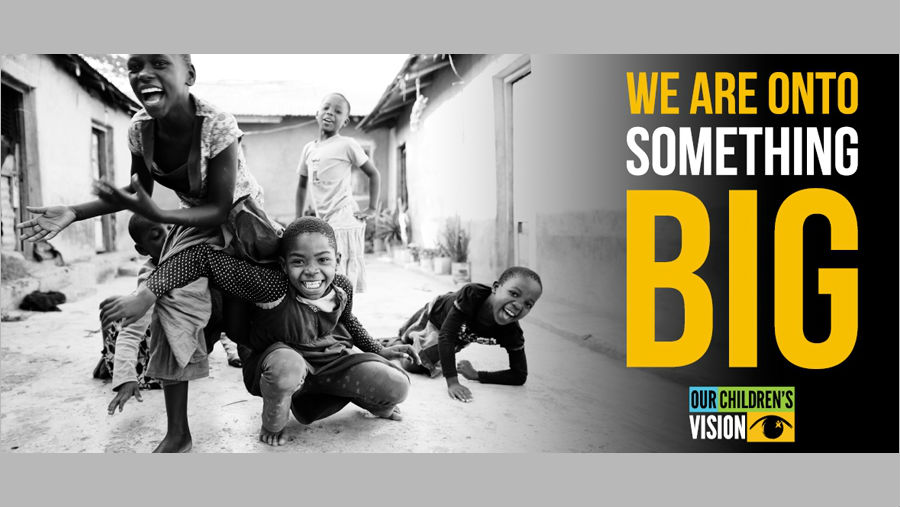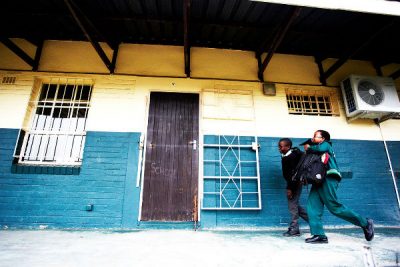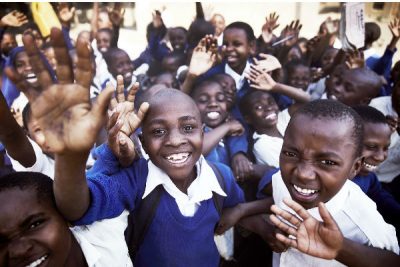Join a powerful, unprecedented alliance for better eye health for all.
Join IAPB-
Choose an alternate language here

In April 2016, Our Children’s Vision was launched with the ambitious goal of reaching 50 million children with vision services by 2020.
In 2018, through the hard work of our 79 partner organisations in 55 countries, the half-way milestone for this ambitious project was met and passed ahead of schedule.
27 million children from America to Zimbabwe have had their vision tested. Over 1,700,000 pairs of glasses have been handed out. That’s over 1,700,000 children whose worlds have suddenly grown brighter and larger with easier access to education, with full participation in their communities, and with all the possibilities that exist in a child’s dreams for their future.
Billal knew he was at a major disadvantage at school. Then Vision Aid Overseas, a partner in Our Children’s Vision, came to his school, provided him with the glasses he needed, and changed his life.
“Now I can sit anywhere in the classroom as the other students. I am very happy with my eyesight and last semester I was ranked 1st in my class.” – Billal
Billal, and the millions of other children that will be seen before the end of 2020, are the first to benefit from the global drive of Our Children’s Vision to put in place policies and support programs that will see their little brothers and sisters, and one day their own children, taking lifelong clear vision for granted.

$272 billion worth of productivity is lost every year because of vision impairment and other sight conditions. 1.1 billion people worldwide can’t see properly because they have near vision impairment and don’t have access to affordable reading glasses. Almost two billion more suffer from sight conditions treatable with glasses.
With about 90% of the world’s vision impaired living in developing countries, the burden of lost productivity and the economic and social consequences fall heavily on the most vulnerable. These include millions of children living with vision impairment.
Reaching these children, especially those living in rural or remote locations, with trained professionals who can assess their vision is a massive challenge that is global in scale.
It is the challenge that Our Children’s Vision was established to meet.

When Our Children’s Vision was co-founded by Brien Holden Vision Institute and Essilor’s strategic giving fund Vision for Life, we launched knowing that even with the co-founders’ decades of experience in combatting vision impairment in developing countries, we would need the help of partners, each with their expertise, unique experience and local knowledge, to achieve our goal.
“Brien Holden Vision Institute, and our founder Professor Holden, had been calling out for years for vision health screening in children. By starting Our Children’s Vision we saw a chance to not just help today’s children, but to reduce global levels of uncorrected vision impairment in future generations – but we knew that we couldn’t do it alone.” – Amanda Davis, Chief Executive Officer, Brien Holden Vision Institute Foundation.
Our goal of reaching 50 million children around the world is more than ambitious. It is inspiring and it is a rallying point for not just helping today’s children, but for doing the research, developing policies, lobbying governments and putting into place programs around the world to address the eye health of children today and tomorrow.
“By giving children access to vision correction, we are empowering them to achieve their full potential at school, but we are also hoping to give them access to a better future and ultimately to reduce inequalities and poverty in their country.” – Jayanth Bhuvaraghan, Chief Mission Officer, Essilor International and Chairman of Vision for Life.
Our Children’s Vision now has 79 partner organisations in 55 countries. And we want even more.
“We are proud to be a part of what Our Children’s Vision represents: a group of people from different cultures and countries coming together to support a hopeful future for the world. Without collaboration – meeting the global eye care need would be hopelessly impossible.” – Haleigh Cole Perry, International Programs Director, Charity Vision.

The insight that drives Our Children’s Vision, that has helped us to continue to hit our milestones ahead of schedule, is the centrality of school in children’s lives, and the importance education plays in their future.
Around the world governments have recognised schools as not just centres of education, but as access points for delivering health services to children. However, these health services have rarely included even basic vision tests.
This is why as some partners are visiting schools, others are meeting with health and education officials, and still others are performing the basic research that will enable programmes and ensure their successful implementation.
“Vision issues can negatively impact a child’s development and performance in school. Ensuring that these children are identified, have access to and receive quality eye care, and have access to prescribed treatments makes a tremendous impact today and beyond childhood.” – Jeff Todd, President and CEO of Prevent Blindness.
“Without glasses, children with poor vision are at a major disadvantage in school and are unable to benefit from other interventions designed to improve educational outcomes.” – Elizabeth Smith, Co-Founder & Chief Executive, EYElliance.
Teachers will play a big part in any successful implementation. Their care and daily insight into their students’ hurdles and progress places them at the centre of a strategy that addresses the child’s community.
“There are many players involved when it comes to eradicating avoidable blindness among school children – particularly adults within a child’s inner circle. Teachers can be skilled to recognise and diagnose basic eye problems, parents can be educated to identify uncommon behaviour and know how to access care. They can be at the front lines of ensuring children receive the eye care they need.” – Elizabeth Kurian, CEO, Mission for Vision.
New technology plays an important role alongside training. Our Children’s Vision partner Peek Vision has developed a retinal camera attachment for smartphones. Now detailed vision checks can be performed anywhere. The Peek system makes visits to rural and remote locations not just affordable, but highly effective.
“In Kenya, our trial showed that our smartphone eye health system nearly trebled the number of school children receiving eye health services, compared to conventional screening. We also demonstrated the huge potential for scale with nearly 21,000 children being screened in nine days by just 25 teachers. We’re now working with partners – many of them also Our Children’s Vision member organisations – in multiple countries to bring these systems to even more children.” – Dr Andrew Bastawrous, Co-founder and CEO Peek Vision.
Behind the training and the technology, there are thousands of dedicated professionals that have made the progress of Our Children’s Vision so rapid.
“By 2020, we want to check the vision of 22,000 children in Ecuador. That is one of our goals and we are inspired, in part, by the fact that dozens of other Our Children’s Vision partners around the world are playing their part. Our challenges are different, and our goals may vary in time-frame and scope, but they all have the common thread of getting eye care to children.” – Patricia Duran Ospina, Universidad Tecnica de Manabi.
Since 2016, Our Children’s Vision has helped develop comprehensive guidelines for school health programs in low to middle-income countries, successfully advocated for a School Eye Health Working Group within the International Agency for the Prevention of Blindness, and with the Global Partnership for Education and the World Bank completed two in-depth reports on child eye health in 43 countries and children’s access to eye care services in low- and middle-income countries.
Our partners have worked with the national governments of Cambodia, Tanzania, Uganda and Zimbabwe to have vision health included in their school health programs, as well as the state and provincial governments of France and the USA.
“We have advocated for eye exams for children before they enter kindergarten. With the help of Senator Sweeney’s office in New Jersey, USA we have submitted a bill that will directly influence our children’s future. This collaboration is a true testament to what can happen when we work together, focus on the needs of our youngest citizens to set them up for success.” – Kristan Gross, Global Executive Director, Vision Impact Institute.
This list of vision-inclusive school health programmes will continue to grow as we head towards 2020 and 50 million children.
Schools are the foundation of our strategy, but not all children make it to class.
“It isn’t just children in schools who are in need of eye care. Sadly, there are millions of children who are not enrolled in a school system. We all work to ensure those children do not fall through the cracks, that they are not left behind.” – Sue Chiles, Managing Director, World Council of Optometry.
It is through the insight and assistance of all our partners that we have been able to progress so far so quickly.
But the hardest part is yet to come. There are schools farther out, children living more remotely; there are regions, countries and districts Our Children’s Vision partners have not yet reached and that we need to reach if we are to hit our target by 2020.
“We know that to truly close the gap in care we need a gamut of skills and services, and not just those that are obvious to eye care. From customising spectacles in optical workshops, providing eye-care education to teachers, the media sharing our public health messages, courier services linking professionals and patients across countries, and Ministries of Health and Education carrying our policies – all of these and dozens more hold a place in making sure children can see clearly. No one organisation, no one industry can do it alone.” – Wolfgang Gindorfer, NIURE Program Director, Light for the World.
Join us. Partner with us, or support us however you can. Be part of this important mission to change the lives of 50 million children by 2020, and the countless more who will come after them.
Image: Simon Way/Sightsavers